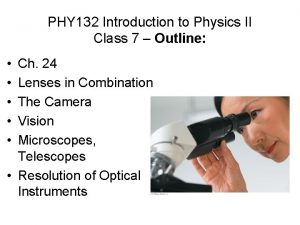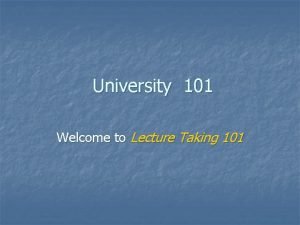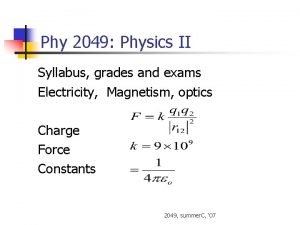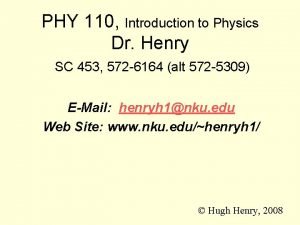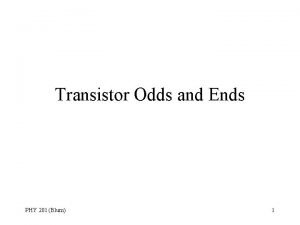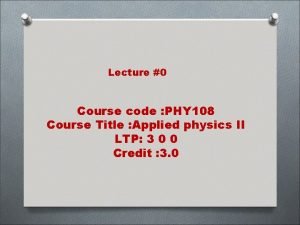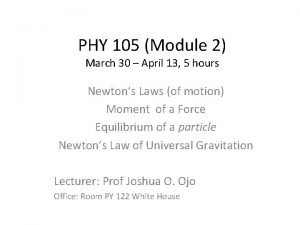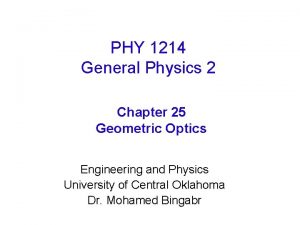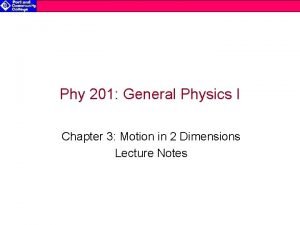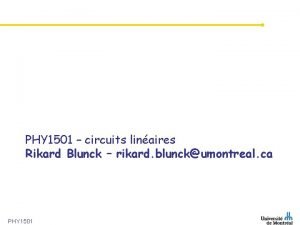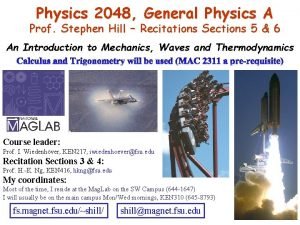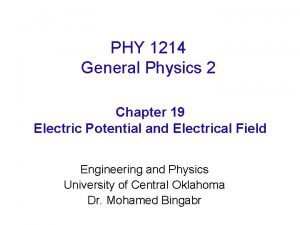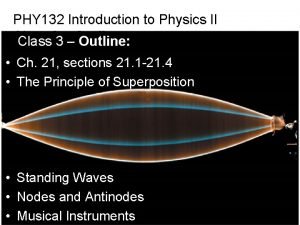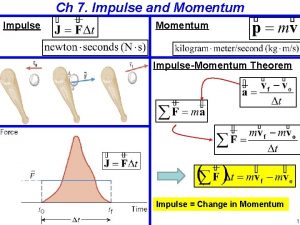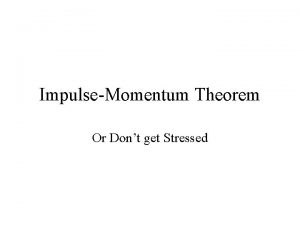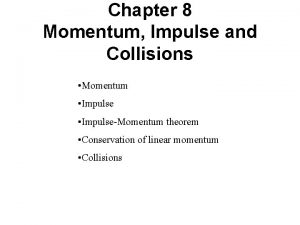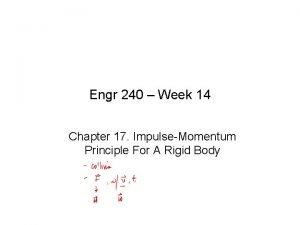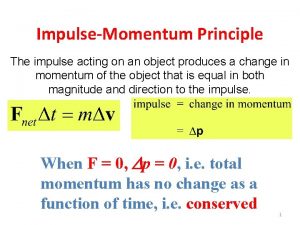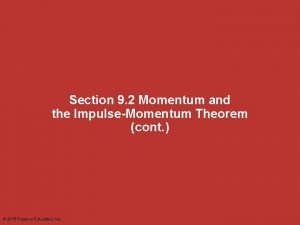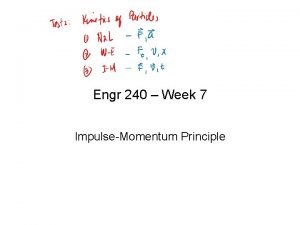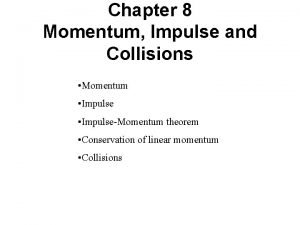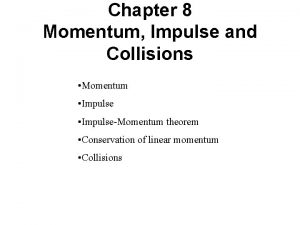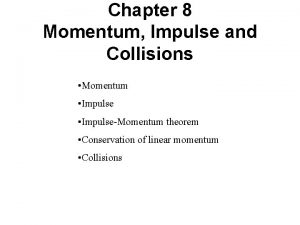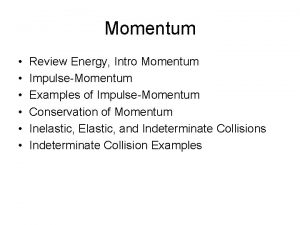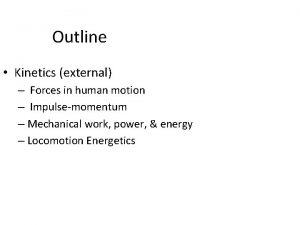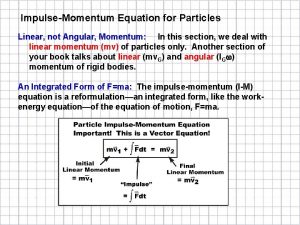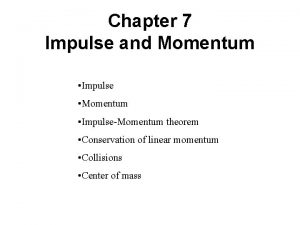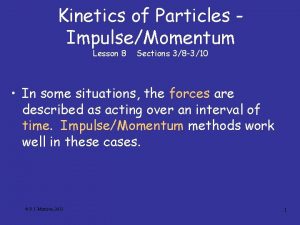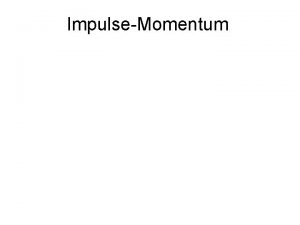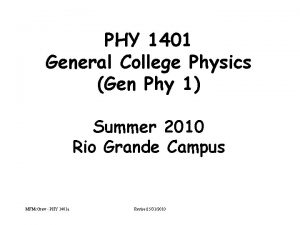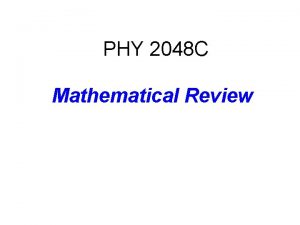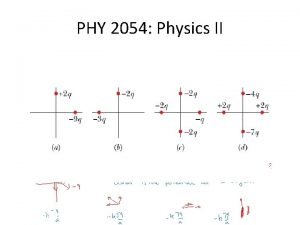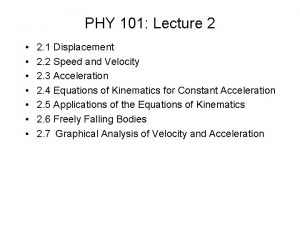PHY 101 Lecture 7 7 1 The ImpulseMomentum





























- Slides: 29

PHY 101: Lecture 7 • 7. 1 The Impulse-Momentum Theorem • 7. 2 The Principle of Conservation of Linear Momentum • 7. 3 Collision in One Dimension • 7. 4 Collisions in Two Dimensions • 7. 5 Center of Mass

PHY 101: Lecture 7 Impulse and Momentum 7. 1 The Impulse-Momentum Theorem

Force and Collision Time

Definition of Impulse • Vector quantity • Impulse J of a force is product of average force Favg and time interval Dt during which the force acts ØJ = Favg. Dt • Direction of Impulse is same as direction of average force • SI Units of Impulse: Newton second (Ns)

Definition of Linear Momentum • Linear momentum p of an object is the product of the object’s mass m and velocity v Øp = mv • Linear momentum is a vector that has the same direction as velocity • Symbol: p • SI Units of Linear Momentum: kilogram meter/second (kg m/s)

Linear Momentum – Example 1 • What is magnitude of linear momentum of a 7. 1 -kg bowling ball traveling at 12 m/s? Øp = mv = 7. 1(12) = 85. 2 kg(m/s)

Linear Momentum – Example 2 • Linear momentum of a runner in a 100 -m dash is 7. 5 x 102 kg(m/s) • The runner’s speed is 10 m/s • What is his mass? Øp = mv Ø 750 = m(10) Øm = 750/10 = 75 kg

Momentum vs. Kinetic Energy • Momentum and Kinetic Energy are two different properties of matter • Massless radiation has Momentum but not Kinetic Energy, but that is PHY 102 • Formula relationship is ØKE = p 2 / 2 m

Impulse and Momentum Relationship Øp = mv • Dp = D(mv) = m(Dv) • Dp/Dt = m(Dv/Dt) = ma = F (Newton’s 2 nd Law) • Dp = F(Dt) = J • Note: Dp = pf – pi, Dt = tf – ti • Note: We assumed that m is constant, but m could also change. We will see examples where this is the case

Impulse – Momentum Theorem • When a net force acts on an object, the impulse of this force is equal to the change in momentum of the object (SF)Dt = mvf - mvi Impulse = Change in Momentum

Impulse-Momentum Theorem Example 1 • A 0. 20 -kg softball is tossed upward and hit horizontally by a batter • Softball receives an impulse of 3. 0 Ns • With what horizontal speed does the ball move away from the bat? ØJ = pf – pi = mvf - mvi ØInitial momentum is 0 ØJ = mvf Øvf = J/m = 3/0. 20 = 15 m/s

Impulse-Momentum Theorem Example 2 • Automobile with linear momentum of 3. 0 x 104 kg(m/s) in +x-direction is brought to a stop in 5. 0 s • What is the average braking force? ØJ = Ft = pf – pi ØFinal momentum is zero ØF = – pi /t = -(+3. 0 x 104) / 5 = - 6000 N

Impulse-Momentum Theorem Example 3 • A pool player imparts an impulse of 3. 2 Ns to a stationary 0. 25 -kg cue ball with a cue stick • What is the speed of the ball just after impact? ØJ = FDt = pf – pi = mvf - mvi ØInitial momentum is zero ØJ = mvf Øvf = J/m = 3. 2/0. 25 = 12. 8 m/s

Impulse-Momentum Theorem Example 4 • A car of 1500 kg is traveling in +x-direction at 20 m/s • Force acts on car in the +x-direction for 30 seconds • Final velocity of car is 40 m/sec in the +x-direction • What is the force? ØJ = FDt = pf – pi = mvf - mvi ØJ = 1500(+40) – 1500(+20) ØJ = 60000 – 30000 = 30000 ØF = 30000/Dt = 30000/30 = 1000 N

Impulse-Momentum Theorem Example 5 • Machine gun fires 15 bullets (mass 0. 020 kg) per second • Velocity of bullets is 800 m/sec in the +x-direction • What is the force on the machine gun? ØChange in momentum of 1 bullet = mvf – mvi = (0. 020)800 = 16 ØChange in momentum for all bullets in second = 16(15) = 240 N ØThis is average force on the bullets ØForce on gun is equal and opposite, -240 N

PHY 101: Lecture 7 Impulse and Momentum 7. 2 The Principle of Conservation of Linear Momentum

Conservation of Momentum Internal / External Forces • Two types of forces act on the system ØInternal forces – Forces that the objects within the system exert on each other ØExternal forces – Forces exerted on the objects by agents external to the system

Conservation of Momentum Collision between Two Balls 1 • System is two balls that are colliding • F 12 is the force exerted on ball 1 by ball 2 • F 21 is the force exerted on ball 2 by ball 1 • Forces are internal forces • Forces are equal in magnitude but opposite in direction ØF 12 = - F 21 • Force of gravity also acts on the balls • The weights are external forces • The weights are W 1 and W 2 • Impulse-Momentum Theorem is applied to the two balls

Conservation of Momentum Collision between Two Balls 2 • (W 1 + F 12)Dt = m 1 vf 1 – m 1 vi 1 • (W 2 + F 21)Dt = m 2 vf 2 – m 2 vi 2 • Add these equations • (W 1+W 2+F 12+F 21)Dt = (m 1 vf 1+m 2 vf 2) – (m 1 vi 1+m 2 vi 2) • (sum external forces+sum internal forces)Dt = pf - pi • Sum of internal forces is zero (Newton’s Third Law) • (sum of external forces)Dt = pf – pi • Suppose that the sum of external forces is zero • pf = p i • This is conservation of momentum

Conservation of Momentum • Total linear momentum of an isolated system remains constant • An isolated system is one for which the vector sum of the external forces acting on the system is zero • Note: It is important to realize that the total linear momentum may be conserved even when the kinetic energy is not conserved

Conservation of Momentum Example 1 • A 60 -kg astronaut floats at rest in space • He throws his 0. 50 -kg hammer such that it moves with a speed of 10 m/s in the -x-direction • What happens to the astronaut? ØAstronaut is object 1 and hammer is object 2 ØMomentum is conserved, pf = pi ØInitial momentum is zero Øm 1 v 1 f + m 2 v 2 f = m 1 v 1 i + m 2 v 2 i = 0 Ø 60 v 1 f + 0. 5(-10) = 0 Øv 1 f = 5/60 = +0. 0833 m/s

Conservation of Momentum Example 2 • An 800 -kg car travelling in the +x-direction with a velocity of 30 m/sec • It hits a stationary truck of 3200 kg • The car and truck stick together • What is speed of combined masses after the collision? ØThe car is object 1 and the truck object 2 Øpf = p i Ø(m 1 + m 2)vf = m 1 v 1 i + m 2 v 2 i Ø 4000 vf = 800(+30) + 3200(0) = 24000 Øvf = 24000 / 4000 = +6 m/s

Conservation of Momentum Example 3 • A car of mass 1200 kg is traveling 30 m/s in the +xdirection • The car collides with a truck of 3200 kg traveling in the –x-direction at 20 m/s • After the collision, the truck comes to a stop • What is the velocity of the car? ØThe car is object 1 and the truck object 2 Øpf = p i Øm 1 v 1 f + m 2 v 2 f = m 1 v 1 i + m 2 v 2 i Ø(1200)v 1 f = 1200(30) + (3200)(-20) = -28000 Øv 1 f = -28000/1200 = -23. 33 m/s

PHY 101: Lecture 7 Impulse and Momentum 7. 3 Collisions in One Dimension

1 -Dimension Collisions • Total linear momentum is conserved when two objects collide • If they are an isolated system (no external forces) • Collisions are classified according to whether the total kinetic energy changes during the collision: ØElastic collision – Total kinetic energy of system after collision is equal to total kinetic energy before collision ØInelastic collision – Total kinetic energy of system is not the same before and after collision ØIf the objects stick together after colliding, the collision is said to be completely inelastic • When a collision is completely inelastic, the greatest amount of kinetic energy is lost

Elastic Collision 1 • Ball 1 initially is moving in the +x-direction • Ball 2 initially is not moving • The two balls collide and bounce off each other with no loss of total kinetic energy • Each ball moves off with a separate velocity • What are the velocities of the two balls after the collision?

Elastic Collision 2 • m 1 = m 2 • v 1 = 0 • m 1 >>> m 2 • v 1 = u 1 • m 1 <<< m 2 • v 1 = -u 1 v 2 = 2 u 1 v 2 = 0

PHY 101: Lecture 7 Impulse and Momentum 7. 4 Collisions in Two Dimension Skipped

PHY 101: Lecture 7 Impulse and Momentum 7. 5 Center of Mass Skipped
 What is farsightedness called
What is farsightedness called 01:640:244 lecture notes - lecture 15: plat, idah, farad
01:640:244 lecture notes - lecture 15: plat, idah, farad Physics 101 lecture 1
Physics 101 lecture 1 Physics 101 lecture notes pdf
Physics 101 lecture notes pdf Physics 101 lecture
Physics 101 lecture Waves physics pdf
Waves physics pdf Lecture 101
Lecture 101 Phy 2049
Phy 2049 Eye phy
Eye phy Phy 1214
Phy 1214 Phy 110
Phy 110 Pa msu
Pa msu Life phy
Life phy Phy
Phy Phy108
Phy108 Phy 113 past questions and answers
Phy 113 past questions and answers Phy-105 5 discussion
Phy-105 5 discussion General physics
General physics Phy 2049
Phy 2049 Vx=vox+axt
Vx=vox+axt Phy
Phy The great orthogonality theorem
The great orthogonality theorem Rikard blunck
Rikard blunck Atm packet phy
Atm packet phy Phy tgen
Phy tgen Phy 121 asu
Phy 121 asu Loncapa fsu
Loncapa fsu Phy 1214
Phy 1214 Phy
Phy Phy 132
Phy 132
